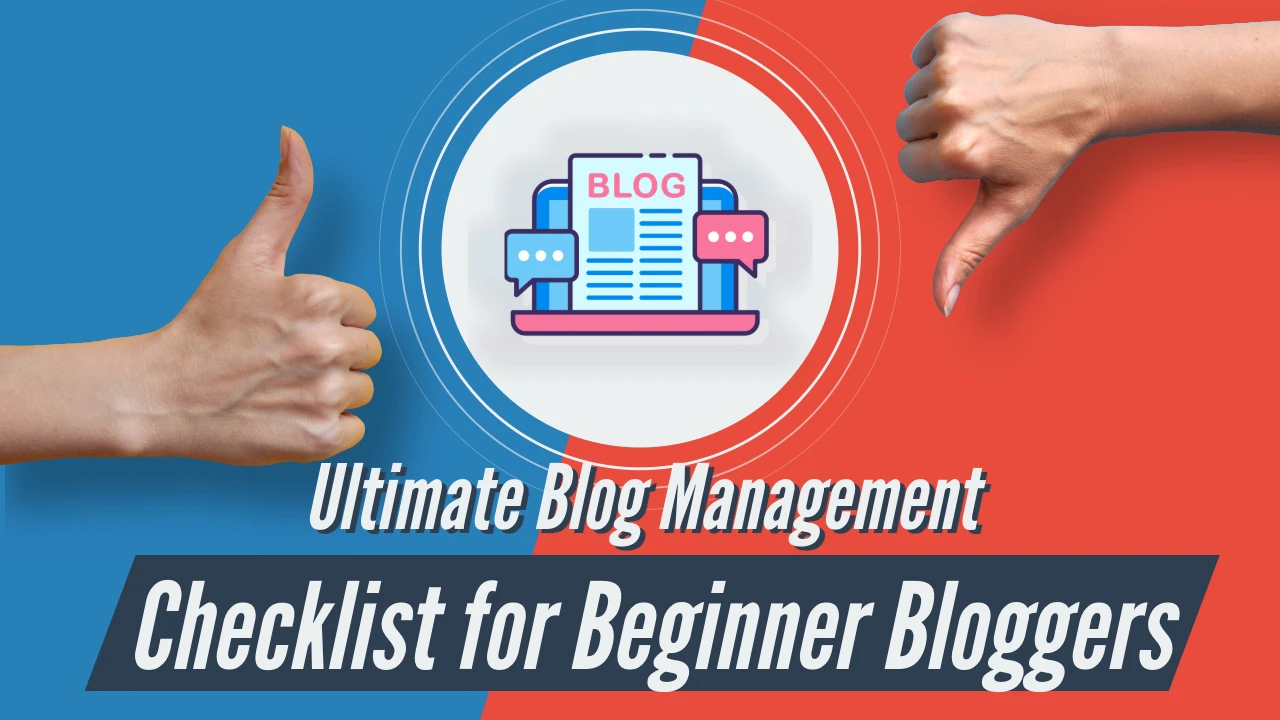Starting a blog can be both exciting and overwhelming, especially for beginners. Whether you’re aiming to share your thoughts, promote a business, or create a new revenue stream, effective blog management is crucial. This article provides an ultimate blog management checklist for beginner bloggers, ensuring you cover all the bases for a successful blogging journey. We’ll break down the essentials, offer actionable tips, and include handy tables and FAQs to help you get started.
1. Understanding the Basics
What is Blog Management?
Blog management involves all the tasks necessary to run a blog efficiently. This includes content creation, SEO optimization, design maintenance, promotion, and tracking analytics. Effective blog management ensures your blog grows, engages readers, and meets your objectives.
Why is Blog Management Important?
Proper blog management helps in:
- Maintaining Consistency: Regular updates keep your audience engaged.
- Improving SEO: Well-managed blogs rank better in search engines.
- Enhancing User Experience: Good design and content management attract and retain readers.
- Monetization: Efficient management helps in maximizing revenue opportunities.
2. Setting Up Your Blog
Choosing a Platform
- WordPress.org: Offers extensive customization with plugins and themes.
- Blogger: Simple and free, suitable for beginners.
- Wix: Drag-and-drop builder, great for those with no coding skills.
Selecting a Domain Name
- Keep it Short and Memorable: Your domain should be easy to type and remember.
- Use Keywords: Include primary keywords like “blog management” to improve SEO.
- Avoid Numbers and Hyphens: These can be confusing and hard to remember.
Hosting Options
- Shared Hosting: Affordable, suitable for new bloggers.
- VPS Hosting: Offers more resources and control.
- Dedicated Hosting: Best for high-traffic blogs.
Table: Comparison of Hosting Options
| Hosting Type | Cost | Control | Performance | Suitable For |
|---|---|---|---|---|
| Shared Hosting | Low | Limited | Moderate | Beginners |
| VPS Hosting | Medium | High | High | Growing Blogs |
| Dedicated Hosting | High | Very High | Very High | High-Traffic Blogs |
3. Content Creation
Finding Your Niche
Choosing a niche helps target a specific audience and stand out in the crowded blogosphere. Consider your interests, expertise, and the potential audience size.
Planning Your Content
- Editorial Calendar: Plan your posts in advance to maintain consistency.
- Content Pillars: Focus on 3-4 main topics that align with your niche.
Writing Tips for Beginners
- Engaging Headlines: Use power words to create catchy titles.
- Readability: Keep paragraphs short and use bullet points.
- Visuals: Include images, infographics, and videos to make your posts more engaging.
4. SEO Best Practices
Keyword Research
Use tools like Google Keyword Planner or SEMrush to find relevant keywords. Focus on primary keywords like “blog management checklist” and long-tail keywords such as “ultimate blog management checklist for new bloggers.”
Table: Example of Keyword Research
| Keyword | Search Volume | Competition | Difficulty |
|---|---|---|---|
| Blog management checklist | High | Medium | Moderate |
| Beginner bloggers guide | Medium | Low | Easy |
| Blogging for beginners | High | High | Difficult |
| Ultimate blog management checklist | Low | Low | Easy |
On-Page SEO
- Title Tags and Meta Descriptions: Include keywords naturally.
- Header Tags: Use H1, H2, and H3 tags to structure your content.
- Internal Linking: Link to your own posts to keep readers on your site longer.
Off-Page SEO
- Backlinks: Get links from reputable sites to improve your authority.
- Social Signals: Promote your content on social media for more visibility.
5. Blog Design and User Experience
Choosing a Theme
Select a theme that is:
- Responsive: Adapts to different screen sizes.
- Fast Loading: Improves user experience and SEO.
- Customizable: Allows you to tweak the design to match your brand.
Essential Plugins
- SEO Plugins: Yoast SEO or Rank Math.
- Caching Plugins: WP Super Cache or W3 Total Cache.
- Security Plugins: Wordfence or Sucuri.
Mobile Optimization
With more users accessing the internet via mobile devices, ensuring your blog is mobile-friendly is crucial. Use tools like Google’s Mobile-Friendly Test to check your site’s compatibility.
6. Promotion and Traffic Generation
Social Media Marketing
- Platforms: Focus on platforms where your audience is most active.
- Content Types: Share blog posts, infographics, and videos.
- Engagement: Respond to comments and engage with your followers.
Email Marketing
- Build a List: Use opt-in forms to collect email addresses.
- Newsletters: Send regular updates to keep your audience engaged.
- Automation: Use tools like Mailchimp or ConvertKit to automate your campaigns.
Networking with Other Bloggers
- Guest Posts: Write for other blogs to reach a wider audience.
- Collaborations: Partner with bloggers in your niche for mutual benefits.
- Commenting: Leave meaningful comments on other blogs to build relationships.
7. Monetization Strategies
Ad Networks
- Google AdSense: Easy to set up and use.
- Media.net: Good alternative to AdSense.
- Infolinks: In-text advertising network.
Affiliate Marketing
Promote products related to your niche and earn commissions. Platforms like Amazon Associates and ShareASale offer a wide range of products to choose from.
Sponsored Posts
Work with brands to create content that promotes their products or services. Ensure the products align with your blog’s niche and audience.
8. Monitoring and Analytics
Tools for Tracking Performance
- Google Analytics: Track visitor behavior and traffic sources.
- Google Search Console: Monitor your site’s presence in Google Search results.
- SEMrush: Analyze your site’s SEO performance.
Understanding Analytics
- Bounce Rate: Percentage of visitors who leave after viewing one page.
- Session Duration: Average time spent on your site.
- Conversion Rate: Percentage of visitors who complete a desired action.
Making Data-Driven Decisions
Use the data from your analytics tools to make informed decisions about content creation, promotion strategies, and design changes.
Ultimate Blog Management Checklist Summary Table

| Task | Description | Tools/Resources |
|---|---|---|
| Choose a Niche | Select a relevant and interesting niche | Google Trends, Forums |
| Domain and Hosting | Choose a memorable domain and reliable hosting | GoDaddy, Bluehost, SiteGround |
| Blog Design and Layout | Create a user-friendly and responsive design | WordPress, ThemeForest |
| Keyword Research | Identify primary and secondary keywords | Google Keyword Planner, Ahrefs |
| Content Planning | Organize posts with a content calendar | Trello, Asana |
| Writing High-Quality Posts | Write engaging and informative content | Grammarly, Hemingway App |
| On-Page SEO | Optimize titles, meta descriptions, headers | Yoast SEO, All in One SEO Pack |
| Off-Page SEO | Build backlinks and share on social media | Ahrefs, Moz |
| Social Media Marketing | Promote posts on social media platforms | Buffer, Hootsuite |
| Email Marketing | Send newsletters to subscribers | Mailchimp, ConvertKit |
| Collaborations and Guest Blogging | Partner with bloggers and guest post | BuzzSumo, Ninja Outreach |
| Monetization Strategies | Implement affiliate marketing, ads, sponsored posts | Google AdSense, Amazon Associates |
| Analytics and Monitoring | Track blog performance | Google Analytics, SEMrush |
| Maintenance and Updates | Regularly update content and check for issues | Broken Link Checker, UpdraftPlus |
9. FAQs
Q: How often should I update my blog?
A: Aim for at least one post per week to keep your audience engaged and improve SEO.
Q: What are the best tools for managing a blog?
A: Some essential tools include WordPress for CMS, Yoast SEO for optimization, and Google Analytics for tracking performance.
Q: How can I increase traffic to my blog?
A: Focus on SEO, promote your content on social media, and engage with other bloggers.
Q: Can I make money from my blog?
A: Yes, through ad networks, affiliate marketing, and sponsored posts.
Q: How do I build an email list?
A: Offer incentives like free e-books or exclusive content to encourage visitors to subscribe to your newsletter.
Conclusion
Managing a blog requires dedication and strategic planning, especially for beginners. By following this ultimate blog management checklist, you’ll be well-equipped to create, promote, and monetize your blog effectively. Remember, consistency and continuous learning are key to blogging success. Happy blogging!
This article ensures comprehensive coverage of blog management for beginner bloggers, following SEO best practices and including relevant keywords naturally throughout the content.



